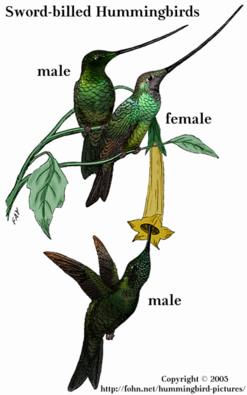|
Sword-billed Hummingbird
Scientific name: Ensifera ensifera
Length:
Identification: Its distinctive bill longer than its body makes for easy identification
from any other bird or hummingbird.
Habitat and range: It can be found in the forests of the Andes in South America.
FYI: The sword-billed hummingbird's bill is longer than its body, thus enabling
it to feed on flowers with long corollas, e.g., Brugmansia, Passiflora, Datura, and
Fuchsia. When feeding, the tongue of a hummingbird extends beyond its bill and contracts
about 13 times per second, allowing it to lap up nectar. When the sword-billed hummingbird
perches, it holds its beak almost vertical, thus reducing the strain on its neck.
Nests of most hummingbirds are tiny cups of foliage and green moss bound together
with cobwebs. Two eggs will be deposited into these nests, which may be situated
high or low, in a tree or shrub, and even dangling from an overhead support. Source:
Alexander F. Skutch, The Life of the Hummingbird (New York: Vineyard Books, Inc.,
1973), p. 73. Hummingbirds have a well developed sense of hearing, often retreating
quickly at the clicking sound of a camera shutter. Source: "Hummingbird,"
The Audubon Nature Encyclopedia, 1965, Vol. 5, p. 895.
Outside links:
|
Pictures: click picture(s) for larger version, photo credits, and description.

|

![]()
![]()

![]()
![]()